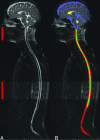Automated Quantitation of Spinal CSF Volume and Measurement of Craniospinal CSF Redistribution following Lumbar Withdrawal in Idiopathic Intracranial Hypertension
- PMID: 27282859
- PMCID: PMC7960475
- DOI: 10.3174/ajnr.A4837
Automated Quantitation of Spinal CSF Volume and Measurement of Craniospinal CSF Redistribution following Lumbar Withdrawal in Idiopathic Intracranial Hypertension
Abstract
Background and purpose: Automated methods for quantitation of tissue and CSF volumes by MR imaging are available for the cranial but not the spinal compartment. We developed an iterative method for delineation of the spinal CSF spaces for automated measurements of CSF and cord volumes and applied it to study craniospinal CSF redistribution following lumbar withdrawal in patients with idiopathic intracranial hypertension.
Materials and methods: MR imaging data were obtained from 2 healthy subjects and 8 patients with idiopathic intracranial hypertension who were scanned before, immediately after, and 2 weeks after diagnostic lumbar puncture. Imaging included T1-weighted and T2-weighted sequences of the brain and T2-weighted scans of the spine. Repeat scans in 4 subjects were used to assess measurement reproducibility. Whole CNS CSF volumes measured prior to and following lumbar puncture were compared with the withdrawn amounts of CSF.
Results: CSF and cord volume measurements were highly reproducible with mean variabilities of -0.7% ± 1.4% and -0.7% ± 1.0%, respectively. Mean spinal CSF volume was 77.5 ± 8.4 mL. The imaging-based pre- to post-CSF volume differences were consistently smaller and strongly correlated with the amounts removed (R = 0.86, P = .006), primarily from the lumbosacral region. These differences are explained by net CSF formation of 0.41 ± 0.18 mL/min between withdrawal and imaging.
Conclusions: Automated measurements of the craniospinal CSF redistribution following lumbar withdrawal in idiopathic intracranial hypertension reveal that the drop in intracranial pressure following lumbar puncture is primarily related to the increase in spinal compliance and not cranial compliance due to the reduced spinal CSF volume and the nearly unchanged cranial CSF volume.
© 2016 by American Journal of Neuroradiology.
Figures





References
LinkOut - more resources
Full Text Sources
Other Literature Sources
Medical
